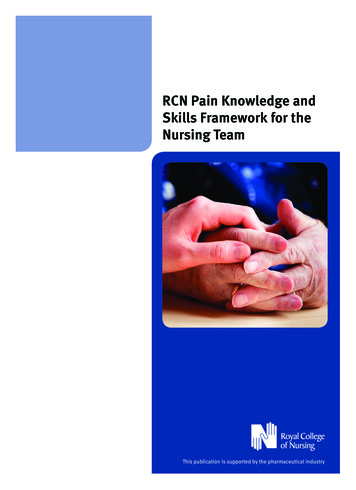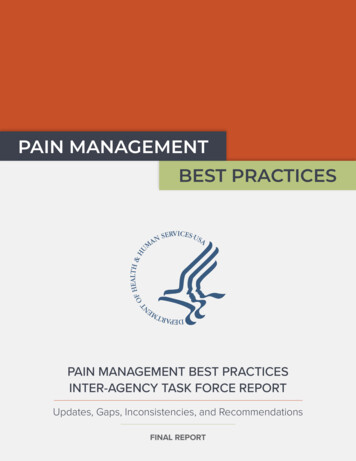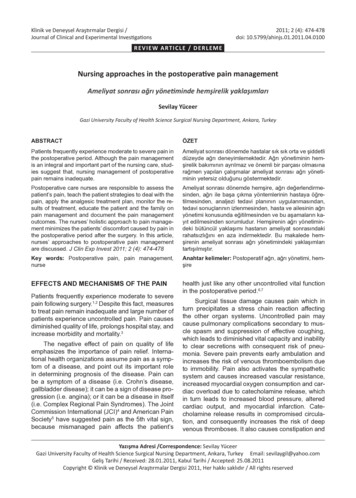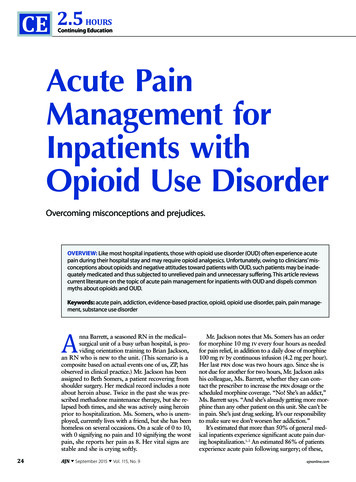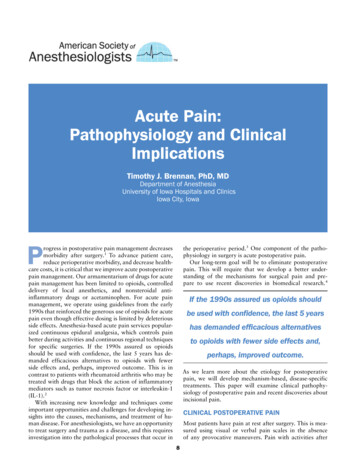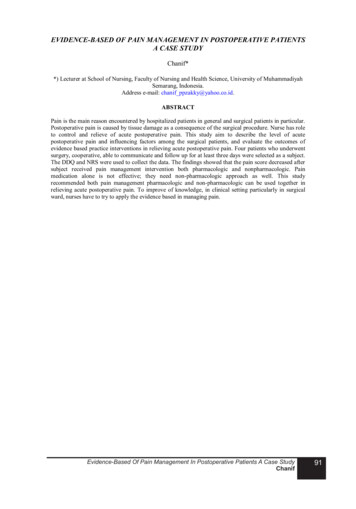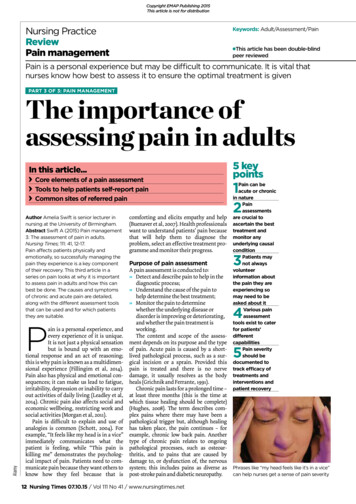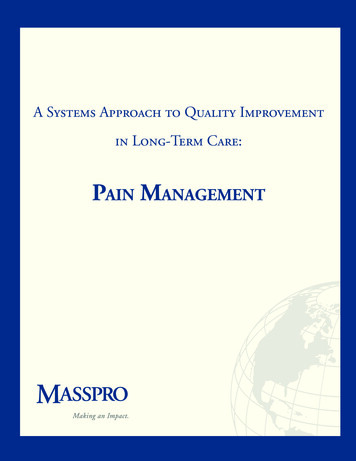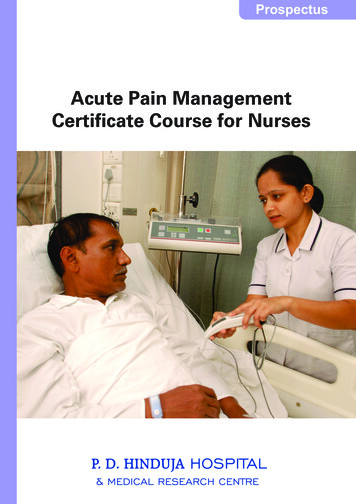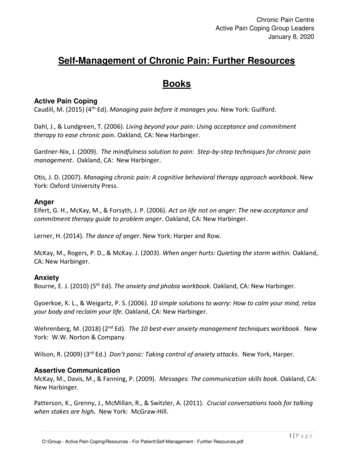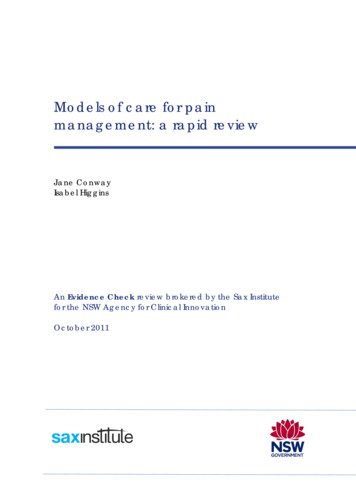
Transcription
Models of care for painmanagement: a rapid reviewJane ConwayIsabel HigginsAn Evidence Check review brokered by the Sax Institutefor the NSW Agency for Clinical InnovationOctober 2011
This rapid review was funded by the Motor Accident Authority of NSW and managed by the SaxInstitute, for the NSW Agency for Clinical InnovationThis report was prepared by Jane Conway and Isabel Higgins.October 2011 The Sax Institute 2012This work is copyright. It may be reproduced in whole or in part for study training purposessubject to the inclusion of an acknowledgement of the source. It may not be reproduced forcommercial usage or sale. Reproduction for purposes other than those indicated aboverequires written permission from the copyright owners.Enquiries regarding this report may be directed to:ManagerKnowledge Exchange ProgramThe Sax @saxinstitute.org.auT: 61 2 95145950F: 61 2 95145951Suggested Citation:Conway J, Higgins I. Models of care for pain management: an Evidence Check rapid reviewbrokered by the Sax Institute (http://www.saxinstitute.org.au), for the NSW Agency for ClinicalInnovation; 2011.Disclaimer:This Evidence Check Review was produced using the Evidence Check methodology in responseto specific questions from the commissioning agency. It is not necessarily a comprehensivereview of all literature relating to the topic area. It was current at the time of production (but notnecessarily at the time of publication). It is reproduced for general information and third partiesrely upon it at their own risk.
ContentsEXECUTIVE SUMMARY . 5Limitations of this Review . 9Background and introduction . 11Description of the method used for the Review. 14Analysis of literature organised around questions aligned to the ‘Changing Modelsof Care’ Framework . 17What are the issues associated with the current model of care? . 17What are the values and principles involved in care delivery? . 22What are the current structures and roles in pain management? . 25What are the care delivery processes and referral patterns and criteria forgetting into and out of the service? . 29What are the patient outcomes? . 34What does the community think of the current model of care? . 41What is the staffing profile and skills mix? What factors affect this? . 42What is the cost of service delivery and what evidence is there that the modelof care is cost effective? . 44Recommendations for a model of care for pain management in NSW Health . 47References . 49AppendicesAppendix 1: Review Proposal . 67Appendix 2 : Sample record of process of initial review of papers – pre feedbackon interim report . 71Appendix 3: Pain Services and Clinics in NSW . 74Appendix 4: Sample of literature reviewed related to care processes . 75
EXECUTIVE SUMMARYThe prevention and management of pain is a key aspect of health care. There isincreasing recognition that pain, particularly persistent pain, is a multidimensionalphenomenon which requires a comprehensive, integrated and multifaceted model ofcare. This Report describes contemporary thinking about pain and its management inorder to identify those factors that must be considered in developing an effectivemodel of care for people who experience pain in NSW.The literature revealed a heightened awareness of the epidemiology and impact ofpain (National Pain Strategy (NPS) 2010; Institute Of Medicine (IOM) 2011). The uniquechallenges of working in the field of pain management, including the need to workwith clients who can have very complex needs, have been identified. Legislation,regulation and health and social policy also impact on how pain is managed. Forexample, factors related to opioid and other substance use, social benefits, medicaland pharmaceutical benefit arrangements, mental health care, aged care, cancercare, indigenous health, rehabilitation and occupational medicine, and palliativecare have been noted to influence and impact pain management field (IOM 2011,NPS 2010).In this Report the aspects that constitute a model of care are described and thefindings of the literature review are discussed in relation to each of these. Arecommended model of care for NSW is proposed based on this. Although there doesnot appear to be a body of evidence that examines the implementation of models ofcare in their entirety, there is a range of research and other literature which providescues as to the attributes of a model of care for more effective management of pain.Moreover there is consensus that failure to intervene appropriately for those whoexperience pain has a number of undesirable risks for the individual, families andcommunities and places increased demand on acute and community services. Inparticular, there is a strong body of evidence that indicates that early, targeted painmanagement plays a significant role in the prevention of long term pain conditions.The questions examined in this literature review were drawn from the Changing Modelsof Care Framework (Queensland Health 2000). The questions and a summary of theanalysis of the literature related to each of them are:1. What are the issues associated with the current model of care?The major problems with the current approaches to pain management are longstanding and well documented. They include: An overreliance on the biomedical view of pain and a concomitant lack ofservices within the biopsychosocial approach to responding to chronic painLimited timely access to existing services for a range of reasonsA need to develop capacity to respond to increasing demand for painmanagement particularly chronic pain as people survive conditions which areassociated with or lead to persistent painThe Sax Institute5
EXECUTIVE SUMMARY A need to better target services to clients experiencing pain who havediffering needs.2. What are the values and principles involved in care delivery?The values and principles which guide care delivery are a commitment to the mosteffective, evidence-based approaches using a population approach to painmanagement. Achieving this requires clear appreciation of the structures and roles ofeach part of the health sector and clearly delineated care delivery processes acrossprimary and acute health care sectors in NSW.3. What are the current structures and roles in pain management? What are the caredelivery processes and referral patterns and criteria for getting into and out of theservice?The current care delivery processes for the management of pain suggest a need to:1) Better define the type of services for specific populations who experience pain2) Promote pain management as a specialty area of practice that workscollaboratively with other specialities to optimise patient experience andoutcomes3) Continue to ensure care processes are founded on research related to thebiopsychosocial view of pain.The services and programs provided at hospitals in NSW appear to vary based on thelocal context and history of the service. It is important that patients are clear about thetypes of services available to them in each Local Health District and that there isreasonable access to pain management services for the population of NSW.There is evidence of a need to: Optimise quality and consistency in care of the person with pain in all settingsirrespective of the nature of pain through greater use of standardised careguidelines, protocols and pathwaysEnsure there are valid and comprehensive screening and assessmentprocesses to ensure the right level of care is available to patientsProvide a range of interventions for both acute and chronic pain - includingbehavioural programs for people with persistent painBetter define the criteria for attendance at specialist pain services and improvethe discharge process from specialist services to community and primary careservices;Optimise case management for those with chronic and complex pain whoneed high levels of supportFurther explore the use of technology to facilitate care processesBetter classify and code pain related presentations and use of services.4. What are the patient outcomes? Is the model of care delivery safe? Does it provideequity of access? Is it based on the most appropriate available evidence?6The Sax Institute
EXECUTIVE SUMMARYPatient outcomes measured are varied but generally researchers seek to determinethe impact of care on factors such as pain intensity and duration, quality of life andfunctional outcomes. Dependent on the intent of the pain management strategy andthe research questions, other aspects that have been examined include participationin work/school; length of stay in hospital, medication usage and use of health careservices.Synthesis of the available literature indicates that positive outcomes for patients aremaximised when there is: Prompt, appropriate and targeted care processes for the management ofacute and chronic painScreening and appropriate referral for those at risk of needing secondary andtertiary interventionUse of multimodal therapies including cognitive based programs that build selfmanagement capacity among those who experience chronic painHigh intensity rather than low intensity care processes for those experiencinghigh levels of distress related to chronic pain.5. What does the community think of the current model of care?The current models of care, particularly for those who experience chronic pain, do notmeet community expectations of timely access to services where staff are responsiveto their needs in supportive ways. There is a need to change community as well asindividual expectations of pain management processes and outcomes. The extent towhich individuals are assisted to understand the nature of their pain impacts onindividual experience and satisfaction and shapes community expectations. Skilledand knowledgeable staff are critical to this process.6. What is the staffing profile and skills mix? What factors affect this?The staffing profile varies dependent on the nature of the service provided. Tertiarychronic pain services are usually staffed with medical staff, clinical psychologists,physiotherapists, and nursing staff who have specialist expertise in pain management.Occupational therapists, pharmacists and psychiatrists may also form part of the corestaff establishment in a pain service. Irrespective of the staff profile of a pain service,close working relationships with other services that enable the effective managementof pain as well as services that may require specialist pain input (e.g. services foroncology, surgery, older person care, chronic diseases and addiction) are essential.There is also a need to ensure that there are administrative personnel who supporteffective clinical service delivery in order to utilise the expertise of clinical staff well.7. What is the cost of service delivery and what evidence is there that the model ofcare is cost effective?There is evidence that the ineffective management of pain is costly to the community.Efforts to better manage pain have been shown to have some impact on the cost ofdelivery across the health care system. However, conclusions about cost effectivenessdepend on where in the care continuum cost savings are measured and how. SomeThe Sax Institute7
EXECUTIVE SUMMARYof the literature shows that delivering a formalised pain service can be expensive butthe quality of pain management is improved. Others question the degree ofimprovement related to the additional cost. There is limited literature that quantifiesthe cost of pain services and their cost effectiveness related to outcomes such asmedication use and use of hospital services. The general consensus is that ascommunity and outpatient care is less expensive than inpatient care in AcuteHospitals, avoidance of admission and use of acute hospital care resources (e.g.Emergency Departments (EDs) is cost effective to the Acute Hospital Care sector.There are also challenges in identifying the costs and benefits associated with themanagement of pain due to limitations in patient classification and coding processes.As a whole, the literature related to the management of pain reflects the need formore effective management of pain, particularly for those who experience chronicpain. This necessitates a model of care which is inclusive of, yet far broader than, thetraditional, biomedical approach which focuses on ‘curing’ pain. Theacknowledgement that chronic pain is very different to acute pain in terms of itsaetiology and complexity has resulted in renewed emphasis on pain as amultidimensional experience that needs to be viewed and managed through abiopsychosocial lens. There a
Prompt, appropriate and targeted care processes for the management of acute and chronic pain Screening and appropriate referral for those at risk of needing seco ndary and tertiary intervention Use of multimodal therapies including cognitive based programs that build self - management capacity among those who experience chronic pain
